- Home
- Edgar Allan Poe
The Science Fiction of Edgar Allan Poe
The Science Fiction of Edgar Allan Poe Read online
THE SCIENCE FICTION OF EDGAR ALLAN POE
EDGAR ALLAN POE was born in Boston in 1809, the son of itinerant actors. Both his parents died within two years of his birth. Edgar was taken into the home of a Richmond merchant, John Allan, although he was never legally adopted. Poe’s relationship with his foster-father was not good and was further strained when he was forced to withdraw from the University of Virginia because Allan refused to finance him. After a reconciliation, Poe entered the Military Academy at West Point in 1830; he was dishonourably discharged in January 1831. It was a deliberate action on Poe’s part and again was largely due to Allan’s tight-fistedness. His early work as a writer went unrecognized and he was forced to earn his living in newspapers, working as an editor in Richmond, Philadelphia and New York. He achieved respect as a literary critic but it was not until the publication of The Raven and Other Poem in 1845 that he gained success as a writer. And, despite his increasing fame, Poe remained in the same poverty which characterized most of his life. In 1836 he married his cousin, Virginia, who was then fourteen; she died eleven years later of tuberculosis.
Poe’s life and personality have attracted almost as much attention as his writing, and he has been variously pictured as a sado-masochist, dipsomaniac, drug addict and manic depressive. There can be little doubt that Poe was a disturbed and tormented man, and like so many of his characters, often driven to the brink of madness. Writing of the effect of Virginia’s death, Poe said: ‘I became insane, with long intervals of horrible sanity. During these fits of absolute unconsciousness, I drank… my enemies referred the insanity to the drink, rather than the drink to the insanity.’ Poe died a few years later in 1849 and was buried in Baltimore beside his wife.
HAROLD BEAVER retired from the chair of American Literature at the University of Amsterdam in 1988. He is an Honorary Professor at the University of Warwick. He is the author of a collection of essays The Great American Masquerade and a study of Huckleberry Finn. His other editions for the Penguin Classics are Herman Melville’s Moby-Dick, Billy Budd, Sailor and Other Stories and Redburn, as well as The Narrative of Arthur Gordon Pym of Nantucket.
The Science Fiction of
Edgar Allan Poe
Collected and edited with an
Introduction and Commentary by
Harold Beaver
PENGUIN BOOKS
PENGUIN BOOKS
Published by the Penguin Group
Penguin Books Ltd, 80 Strand, London WC2R 0RL, England
Penguin Putnam Inc., 375 Hudson Street, New York, New York 10014, USA
Penguin Books Australia Ltd, 250 Camberwell Road, Camberwell, Victoria 3124, Australia
Penguin Books Canada Ltd, 10 Alcorn Avenue, Toronto, Ontario, Canada, M4V 3B2
Penguin Books India (P) Ltd, 11 Community Centre, Panchsheel Park, New Delhi – 110 017, India
Penguin Books (NZ) Ltd, Cnr Rosedale and Airborne Roads, Albany, Auckland, New Zealand
Penguin Books (South Africa) (Pty) Ltd, 24 Sturdee Avenue, Rosebank 2196, South Africa
Penguin Books Ltd, Registered Offices: 80 Strand, London WC2R 0RL, England
www.penguin.com
This selection first published 1976
24
Introduction and Commentary copyright © Harold Beaver, 1976
All rights reserved
Except in the United States of America, this book is sold subject to the condition that it shall not, by way of trade or otherwise, be lent, re-sold, hired out, or otherwise circulated without the publisher’s prior consent in any form of binding or cover other than that in which it is published and without a similar condition including this condition being imposed on the subsequent purchaser
ISBN: 978-0-14-192206-5
Contents
Introduction
A Note on the Text
Bibliography
MS. Found in a Bottle
The Unparelleled Adventure of One Hans Pfaall
The Conversation of Eiros and Charmion
A Descent into the Maelström
The Colloquy of Monos and Una
A Tale of the Ragged Mountains
The Balloon-Hoax
Mesmeric Revelation
The Thousand-and-Second Tale of Scheherazade
Some Words with a Mummy
The Power of Words
The System of Dr Tarr and Prof. Fether
The Facts in the Case of M. Valdemar
Eureka: An Essay on the Material and Spiritual Universe
Mellonta Tauta
Von Kempelen and His Discovery
Commentary
Appendix 1748–1848: Select Chronology of post-Newtonian Science in the Century preceding Eureka
Introduction
ELECTRO-CHEMISTRY dominated the early nineteenth century. Galvani and Watt, Volta and Ohm, Ampère, Bunsen, Morse – its pioneers embedded their very names into the language. Sir Humphry Davy’s researches led to the isolation of potassium and sodium in 1807; of calcium, barium, boron, magnesium and strontium in 1808. His assistant Michael Faraday discovered electromagnetic induction and developed the first dynamo. It was the age of voltaic cells, electrodes, Leyden jars, piles, conductors, ions, insulation, electric circuits, batteries, generators, dynamos, condensers, galvanometers. The fundamental nature of all matter, it became apparent, was electrical.
Coleridge proclaimed:1
In short, from the time of Kepler to that of Newton, and from Newton to Hartley, not only all things in external nature, but the subtlest mysteries of life and organization, and even of the intellect and moral being, were conjured within the magic circle of mathematical formulae. And now a new light was struck by the discovery of electricity, and, in every sense of the word, both playful and serious, both for good and for evil, it may be affirmed to have electrified the whole frame of natural philosophy. Close on its heels followed the momentous discovery of the principal gases by Scheele and Priestley, the composition of water by Cavendish, and the doctrine of latent heat by Black. The scientific world was prepared for a new dynasty; accordingly, as soon as Lavoisier had reduced the infinite variety of chemical phenomena to the actions, reactions, and interchanges of a few elementary substances, or at least excited the expectation that this would speedily be effected, the hope shot up, almost instantly, into full faith, that it had been effected. Henceforward the new path, thus brilliantly opened, became the common road to all departments of knowledge: and, to this moment, it has been pursued with an eagerness and almost epidemic enthusiasm which, scarcely less than its political revolutions, characterize the spirit of the age.
Even electrical and nervous phenomena were linked. That, too, was a tenet of the age – one of Sir John Herschel’s four determinants of electromagnetism. For what of ‘Animal Magnetism’? Had not Mesmer taken Paris by storm with his ‘magnetic’ cures? Coleridge continued: ‘reproduction corresponds to magnetism, irritability to electricity, and sensibility to constructive chemical affinity’.2 No wonder Poe was fascinated. Born midway between the practical triumphs of a Franklin and of an Edison, his aim was to be the comprehensive theorist, and seer, of the electromagnetic age. An amateur mathematician, like his contemporary Morse, ‘even his most unbounded imagination’ (in Dostoyevsky’s phrase) 3 ‘betrays the true American’. Alone he would play the conjuror, constructing a post-Newtonian hypothesis to decipher God Himself, the Father Almighty, in terms of an almighty electric code.
American newspapers of the 1830s and 1840s were agog with strange reports: of ballooning, exotic voyages, premature burials, automata, trances, plagues. In February 1838, while Poe was working in Greenwich Village, the new electric telegraph was demonstrated at th
e White House. On 23 April the Sirius, the first steamship to cross the Atlantic, chugged into New York harbour, followed that same afternoon by Isambard Kingdom Brunel’s Great Western, a 1,300-ton ironclad, which had left England three days later. ‘The Thousand-and-Second Tale of Scheherazade’ was gaily to expound these marvels – with those of the electrotype, daguerreotype, and electrotelegraphic printer. But exploitation of mechanical inventions launched a parallel boom in psychology. Into the vacuum left by Descartes and Newton flooded every form of transcendentalism. The doctrines of Swedenborg, Lavater and Saint-Martin now grew intellectually fashionable. Had not natural forces been harnessed? So too would supernatural. Progress, Democracy, Manifest Destiny, were the cry of the day. All things, physical and metaphysical, would be annexed – like Texas, Cuba, Mexico – to the American Dream. Father Miller and Prophet Joseph Smith, Mormons and Second Adventists, vied with each other for disciples. Mysticism, spiritualism, hypnotism, mesmeric trances, galvanic resuscitation, phrenology, flourished. In 1849, with a greedy rush, Eldorado itself was besieged.
It was an age for amateurs. De Quincey and Coleridge, Emerson and Poe, could still speak as ‘philosophers’, as literary gentlemen. They linger on the very edge between the old Newtonian order and the new, between Sir William Herschel and Clerk Maxwell, between Munchausen and H. G. Wells. Professionalism and the gathering complexity of research had not yet overwhelmed all but committed ‘scientists’. After mid-century such confidence became less and less attainable. Between science and literature no neutral ground now remained. So no room for ‘natural philosophy’ remained – except in that new, eccentric and bastard form, their communal offspring, ‘science fiction’.
The main line of descent is usually reckoned from Verne and H. G. Wells. But Jules Verne himself acknowledged his debt to Poe; so it was the French who first saluted the American as master: ‘le créateur du roman merveilleux-scientifique’.4 Hubert Matthey presented ‘The Facts in the Case of M. Valdemar’, ‘A Tale of the Ragged Mountains’, and ‘A Descent into the Maelström’ as ‘les types d’un genre qui devait se développer après lui’; the genre itself he defined as ‘ce mélange de la logique et de la narration’. And the emphasis ever since (following Poe’s lead) has been on logic, on reason, on coherent forecast and calculation. As the master himself observed in praise of Eureka: ‘these conditions themselves have been imposed upon me, as necessities, in a train of ratiocination as rigorously logical as that which establishes any demonstration in Euclid’.5
Facts and figures, as scholars have demonstrated, were commonly adapted – plagiarized verbatim even – from published sources. That was inevitable, no doubt. It is also irrelevant. Poe is celebrated as ‘Science Fiction Pioneer’ (in Clarke Olney’s phrase) for being the first ‘to base his stories firmly on a rational kind of extrapolation, avoiding the supernatural’.6 Extrapolation! The very concept, borrowed from statistical projection, is his. Even in the gush of a passionate love letter, in mid-flight, he could declare:7
Think, too, of the rare agreement of name… think of all these coincidences, and you will no longer wonder that, to one accustomed as I am to the Calculus of Probabilities, they wore an air of positive miracle.
For the Calculus of Probabilities had been long familiar to Poe from the work of Condorcet and Laplace, Cournot and Quetelet.
‘All that is necessary,’ taught the Marquis de Condorcet, ‘to reduce the whole of nature to laws similar to those which Newton discovered with the aid of the calculus, is to have a sufficient number of observations and a mathematics that is complex enough.’ 8 From a mathematical theory of probability he turned to a social mathematics, or calculus of history, to tame the future: ‘a science to foresee the progressions of the human species’. Even future moral data were to be mathematicized. In the Esquisse d’un tableau historique des progrès de l’esprit humain, he charted human development through nine epochs to the French Revolution, predicting in a tenth the ultimate perfection of man. The Marquis de Laplace,9 in Théorie analytique des probabilités (1812) continued his rigorous approach to formulaic, mathematical prediction.
Poe has nothing but scorn for ‘human-perfectibility’ spokesmen like Condorcet. But his ‘C. Auguste Dupin’, master detective, is heir to the great French tradition. He is Poe’s spokesman in praise of ‘the theory of probabilities – that theory to which the most glorious objects of human research are indebted for the most glorious of illustration’.10 In ‘The Mystery of Marie Rogêt’ he expounds, and refines on, its technique:
It is through the spirit of this principle, if not precisely through its letter, that modern science has resolved to calculate upon the unforeseen. But perhaps you do not comprehend me. The history of human knowledge has so uninterruptedly shown that to collateral, or incidental, or accidental events we are indebted for the most numerous and most valuable discoveries, that it has at length become necessary, in any prospective view of improvement, to make not only large, but the largest allowances for inventions that shall arise by chance, and quite out of the range of ordinary expectation. It is no longer philosophical to base, upon what has been, a vision of what is to be. Accident is admitted as a portion of the substructure. We make chance a matter of absolute calculation. We subject the unlooked for and unimagined, to the mathematical formulae of the schools.
With ‘the Calculus of Probabilities’ it is but a short step from Poe’s Detective to his Science Fiction. For ‘this Calculus’, he explains, ‘is, in its essence, purely mathematical; and thus we have the anomaly of the most rigidly exact in science applied to the shadow and spirituality of the most intangible in speculation’.11
What was once stuff for ritual or religious myths, or tall tales for entertainment, was thus transformed by Poe to a new speculative fiction. Utopian voyages had long presented all kinds of rational laboratories; but Sir Thomas More and his successors were concerned with the permutation of mainly moral and political hypotheses. The hypotheses of science fiction were wholly material, whether psychological or technological. Their pragmatic claim was the inevitable change (for better or for worse) of both man’s outer and his inner or spiritual environment. Yet, cast as fantasy, the pressure persisted towards the journal-entry, in the present tense; not to recollection, but lived intensity; not as theoretical exercises, but adventures (in the tradition of Lucian, Swift, Defoe) by sea, land or air, foraging into the unknown.
In 1785 an Oxford printer had published an anonymous shilling pamphlet, entitled Singular Travels, Campaigns and Adventures of Baron Munchausen. Rudolph Erich Raspe, its author, seems oddly to prefigure Poe. An amateur scientist and antiquarian, who had earlier written on volcanic geology and the Ossianic poems, he even became a fellow of the Royal Society (until a German scandal caught up with him). Equally fascinated by Lucian, the Arabian Nights, Captain Cook’s voyages in the South Seas and the ballooning exploits of Blanchard or the Montgolfier brothers, he became an avid reader of Swift and Defoe. An anonymous and penniless hoaxer, he foisted his fantastical tall tales upon the world. Poe’s ‘The Unparalleled Adventure of One Hans Pfaall’, however, starting from the same grotesquely exaggerated note, soars, once aloft, into a new and mathematically exacting realm. In that shift, in that unbridgeable gap between the poetic quips of Raspe and the scientific imagination of Poe lay the seeds of the new genre. Both insist on their total veracity; both delight in the elusive antics of the absurd. But while the one dallies solely with metaphoric suggestions, the other explicates, rationalizes, presses inexorably on to hoodwink his bourgeois, materialistic audience. The German concludes his baronial descent of Mount Etna with a plunge through the centre of the earth to the South Seas, adding:
This was a much shorter cut than going round and one which no man has ever before accomplished, or even attempted. However, the next time I do it, I shall endeavour to make proper scientific observations.
The American – as balloonist, sailor or mesmerist – from the start played the experimental, philosophical role:
making ‘proper scientific observations’.
But Poe has never been without his detractors. When his originality has not been ignored, it has been undermined. H. Bruce Franklin is the most recent to launch a two-pronged attack. The first concerned his themes:12
Rarely in Poe’s science fiction does one find science itself as a subject and nowhere does one find any kind of true scientist as a consequential figure.
But precisely this respect for the ‘true scientist’ and his ‘science’ is what Poe himself, again and again, rejected: ‘merely scientific men’ he called them, to be trusted with nothing but ‘scientific details’:13
Of all persons in the world, they are at the same time the most bigoted and the least capable of using, generalizing, or deciding upon the facts which they bring to light in the course of their experiments.
Which makes nonsense of Franklin’s second objection – the matter of treatment: 14
But if science fiction is merely a popularizer of science rather than the literature which, growing with science, evaluates it, and relates it meaningfully to the rest of existence, it is hardly worth serious attention.
Very little science fiction, of course, could pass that exacting test. But who would claim that ‘Mesmeric Revelation’, Eureka, or ‘Mellonta Tauta’, for example, are ‘popularizers’? Their very role, successful or not, is the exact opposite: to evaluate scientific method and technological achievement, by confronting both with a vision of life (‘Out of Space – out of Time’) 15 in its widest spiritual dimensions.
Poe’s ‘Sonnet – To Science’,16 written while only twenty, begins:
Science! true daughter of Old Time thou art!
Who alterest all things with thy peering eyes.
Why preyest thou thus upon the poet’s heart,
Vulture, whose wings are dull realities?

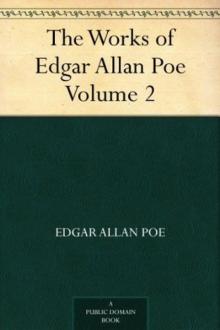 The Works of Edgar Allan Poe — Volume 2
The Works of Edgar Allan Poe — Volume 2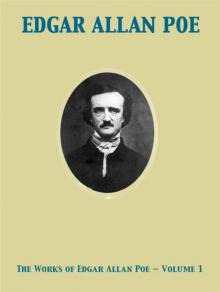 The Works of Edgar Allan Poe — Volume 1
The Works of Edgar Allan Poe — Volume 1 The Works of Edgar Allan Poe — Volume 3
The Works of Edgar Allan Poe — Volume 3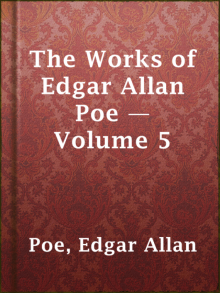 The Works of Edgar Allan Poe — Volume 5
The Works of Edgar Allan Poe — Volume 5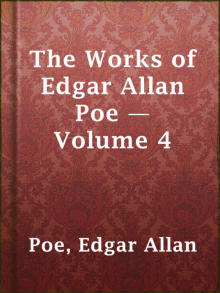 The Works of Edgar Allan Poe — Volume 4
The Works of Edgar Allan Poe — Volume 4 The Tell-Tale Heart
The Tell-Tale Heart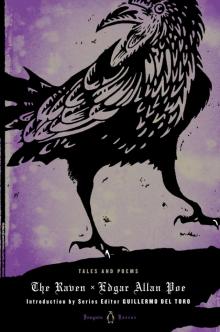 The Raven (Penguin)
The Raven (Penguin)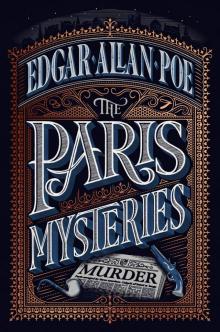 The Paris Mysteries
The Paris Mysteries Tales of Terror from Edgar Allan Poe
Tales of Terror from Edgar Allan Poe The Fall of the House of Usher
The Fall of the House of Usher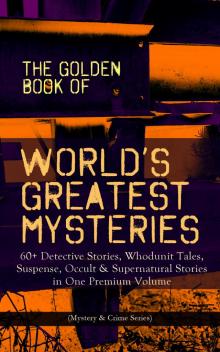 The Golden Book of World's Greatest Mysteries
The Golden Book of World's Greatest Mysteries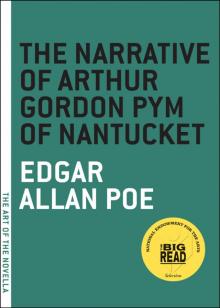 The Narrative of Arthur Gordon Pym of Nantucket
The Narrative of Arthur Gordon Pym of Nantucket Ligeia
Ligeia The Landscape Garden
The Landscape Garden Complete Tales & Poems
Complete Tales & Poems Great Tales and Poems of Edgar Allan Poe
Great Tales and Poems of Edgar Allan Poe The Colloquy of Monos and Una
The Colloquy of Monos and Una The Oblong Box
The Oblong Box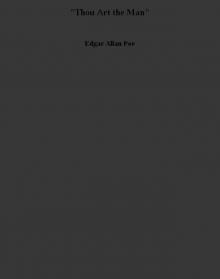 Thou Art the Man
Thou Art the Man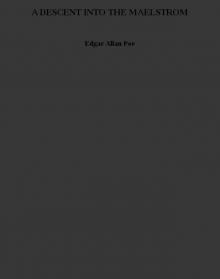 A DESCENT INTO THE MAELSTROM
A DESCENT INTO THE MAELSTROM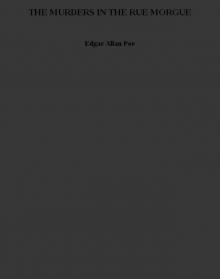 THE MURDERS IN THE RUE MORGUE
THE MURDERS IN THE RUE MORGUE The Business Man
The Business Man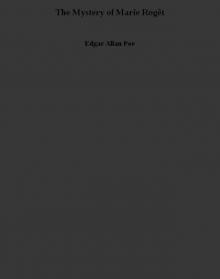 The Mystery of Marie Rogêt
The Mystery of Marie Rogêt Metzengerstein
Metzengerstein The Man That Was Used Up
The Man That Was Used Up William Wilson
William Wilson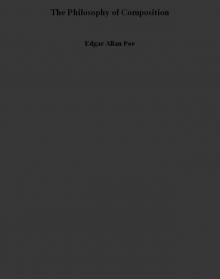 The Philosophy of Composition
The Philosophy of Composition The Portable Edgar Allan Poe
The Portable Edgar Allan Poe Bon-Bon
Bon-Bon A Predicament
A Predicament The Premature Burial
The Premature Burial The Angel of the Odd
The Angel of the Odd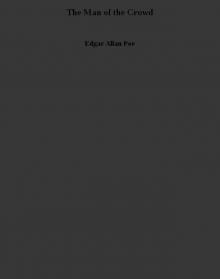 The Man of the Crowd
The Man of the Crowd Never Bet the Devil Your Head
Never Bet the Devil Your Head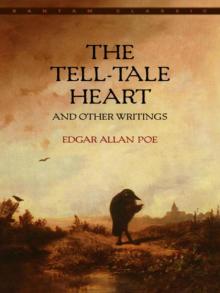 The Tell-Tale Heart and Other Writings
The Tell-Tale Heart and Other Writings The System of Doctor Tarr and Professor Fether
The System of Doctor Tarr and Professor Fether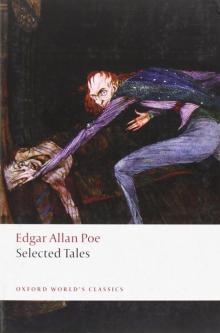 Selected Tales (Oxford World's Classics)
Selected Tales (Oxford World's Classics)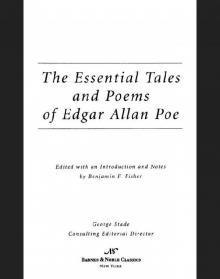 Essential Tales and Poems of Edgar Allan Poe (Barnes & Noble Classics Series)
Essential Tales and Poems of Edgar Allan Poe (Barnes & Noble Classics Series) MS. Found in a Bottle
MS. Found in a Bottle Some Words with a Mummy
Some Words with a Mummy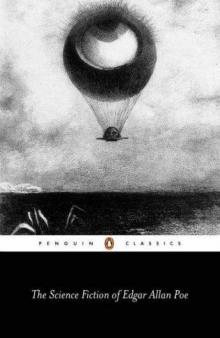 The Science Fiction of Edgar Allan Poe (Penguin Classics)
The Science Fiction of Edgar Allan Poe (Penguin Classics) King Pest
King Pest CRITICISM
CRITICISM How to Write a Blackwood Article
How to Write a Blackwood Article Mystification
Mystification Diddling Considered as One of the Exact Sciences
Diddling Considered as One of the Exact Sciences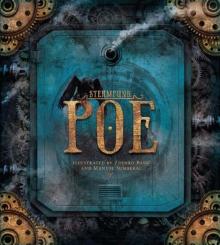 Steampunk Poe
Steampunk Poe The Literary Life of Thingum Bob, Esq.
The Literary Life of Thingum Bob, Esq. Classic Crime Collection
Classic Crime Collection Complete Stories and Poems of Edgar Allen Poe
Complete Stories and Poems of Edgar Allen Poe Berenice
Berenice The Black Cat
The Black Cat The Slender Poe Anthology
The Slender Poe Anthology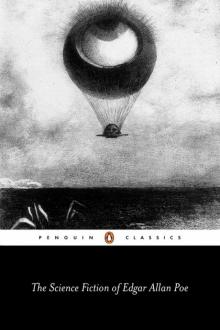 The Science Fiction of Edgar Allan Poe
The Science Fiction of Edgar Allan Poe The Assignation
The Assignation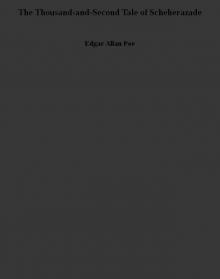 The Thousand-and-Second Tale of Scheherazade
The Thousand-and-Second Tale of Scheherazade The Raven and Other Short Stories
The Raven and Other Short Stories The Spectacles
The Spectacles Hop-Frog
Hop-Frog The Purloined Letter
The Purloined Letter Mellonta Tauta
Mellonta Tauta The Balloon-Hoax
The Balloon-Hoax Landor's Cottage
Landor's Cottage Mesmeric Revelation
Mesmeric Revelation The Pit and the Pendulum
The Pit and the Pendulum